Paving is a beautiful way to make your garden the perfect space for social gatherings, relaxing after long working days or as a unique feature for the outdoor area. Paving is ideal for many landscaping projects and remember, it isn’t just about using paving stones; find out more about the other types of paving materials you can use with our buyer’s guide.
Table of contents
- What is paving?
- Types of paving
- What is the best material for paving slabs?
- Types of paving patterns
- Traditional laying patterns and examples
- Bonus laying pattern and example
- What can I do with paving edging?
What is paving?
Paving is defined as a surface made of flat stones laid in a pattern. It can also refer to the type of material used. However, most people think of slabs or blocks when referring to paving.
Types of paving
There are many different types of paving to choose from. Here are some of the features of each type. This includes defining just how different paving slabs and blocks are.
| Type of paving | Pros | Cons |
| Paving slabs | •Suitable for pathways and patios. •Easy to clean. •Large paving stones work as statement pieces. •Covers a vast area. | •Depending on the material, they can be at risk of cracking under dry conditions. |
| Paving blocks (block paving) | •Suitable for patios and as decorative edging around patios. •Durable and low maintenance. •Easy to install. •Cost-effective. •Modern appearance. •Easy to replace single blocks. •Can be smaller or thicker than slabs. •Variety of colours and designs. | •May not be as unique as paving slabs. |
| Gravel | •Suitable for patios, pathways, and driveways. •Low maintenance •Modern appearance. •Variety of colours, designs, and textures. •Can be used to create curves and waves •Can be used alongside other paving features. | •Needs a waterproof membrane beneath it for a weed-free patio and clean edges. •Needs a gravel pave system pack to keep gravel or stones in place; especially if creating a driveway or pathway. •Needs to be bought in bulk if you're unsure about how much is needed. |
What is the best material for paving slabs?
When it comes to the ‘best’ material, that really depends on what you need to use your paving for. Is it going to be subject to heavy foot traffic? Will it simply be edging to an existing space that is untouched? Check our table to find out the uses of each material to make sure you make an informed decision before you buy.
| Types of material | Pros | Cons |
| Stone | •Suitable for high foot traffic paths and areas that might feature garden tables or chairs. •High porosity. •Long-term use. •Rustic appearance. •Variety of colours for a unique style. •Less likely to crack or break. •Can endure winter weather | •Will need sealing to ensure stones last for the long term. |
| Porcelain | •Suitable for external floors such as patios or around swimming pools. •Low maintenance •High durability. •Unaffected by colour fading. •High scratch and stain resistance. •Contemporary, stylish, elegant design with a smooth surface. •10mm thickness on some porcelain tiles can be used indoors for a house-to-garden flow. | •More expensive initially, but a long-term cost-effective solution. |
| Concrete (reconstituted stone, engineered stone, artificial stone or cast stone) | •Suitable for patios and paving. •Ideal replica to high-end natural slabs. •Long-term use as a budget-friendly solution. •Manufactured using natural mix stone chippings. •Manufactured in a variety of colours, textures, and styles. •Durable with little maintenance needed (annual maintenance of sealing recommended for stain and algae prevention to continue). | •Can be excessive cost depending on the style. |
| Slate | Suitable for patios and traditional or contemporary gardens. Natural material with a timeless style. Hand-selected, hand riven and diamond-sawn. Modern design with multi-coloured styles. | •Can be costly. |
| Limestone | •Suitable for contemporary and traditional settings. •Natural material features natural veining. •Fine detailing and consistent colouring. •Tidy and sleek appearance with a durable finish. | •Limited colours. |
| Granite | •Suitable for use as garden stepping stones. •Strong and resilient material. •Consistent colours with a stylish design. •Sharp edges for a contemporary appearance. •Can be supplied as a garden stepping stone. | •Can be costly depending on certain colours. |
| Sandstone | •Suitable for use as a focal feature, in country gardens and cottage gardens. •Variety of tones, riven profiles, and natural veining styles to choose from. •Rustic style with unique colours to fit requirements for appearance. •Can be matched with stepping stones. | •At higher risk of mould. •Can be at higher risk of water absorption. •At higher risk of scratching. •Low slip resistance. •At higher risk of stains. •Higher risk of appearance going dull. |
Types of paving patterns
The pattern you have will depend on the type of paving you choose. Having said that, paving slabs, blocks, and gravel are not limited to one style only. Each can be used in fresh style settings.
Further on we’ll dive into more about popular paving patterns, including the ever-popular herringbone paving pattern, stretcher bond and much more.
Contemporary laying patterns and examples (h2)
A contemporary style is suited to materials like:
- Limestone
- Granite
- Porcelain
- Slate
Using these materials isn’t as difficult as you may fear. In fact, if you’re laying paving yourself and are new to the process, consider the brick/stretcher bond pattern. This pattern is similar to that of a typical brick wall. It has a simple, uniform appearance which is perfect for the beginner.
Another beginner design is the square stack bond. This is as simple as placing slabs in the formation seen below. Just square pieces of the same size all side by side.
If you want to make the square stack bond design unique, you can also switch it up by mixing and matching assorted colours or creating a design that has slabs on one section mixed and matched but stopping at a certain point to create a fade effect.
Now onto the designs that offer a contemporary appearance.
Herringbone
This style is suitable for interior or exterior projects. It offers that little bit of uniqueness without completely losing its uniform appearance. It’s popular with many block paving DIYers for its design and its uses.
Herringbone is particularly desired for its ability to prevent extended continuous joints from developing. It is typically described as fully interlocked, which is what people adore about the design of the pavements.
As a general design, you can lay the herringbone at a 45-degree or 90-degree angle. Though a 90-degree angle is typically easier to do. An example of this style can be seen below.
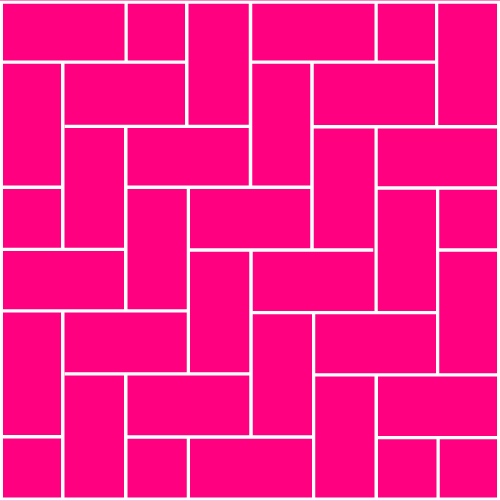
Basketweave
In the world of paving, a “basketweave” pattern is all about creating a look where one set of slabs seems to vanish under another set arranged at a 90-degree angle, only to reappear on the opposite side, giving the illusion of a woven design.
Within this category, you’ll find various styles of basketweave, including the double basket weave pattern.
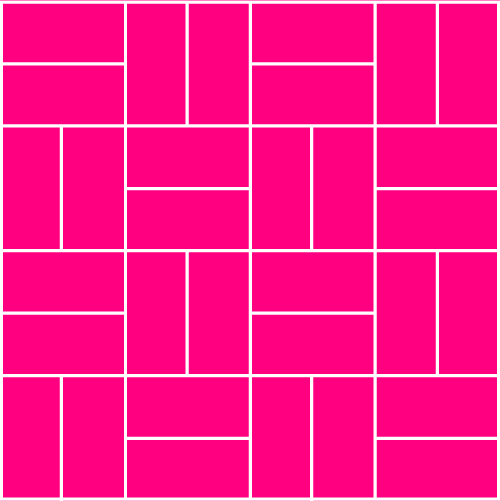
Header and border designs
This one is self-explanatory and great for beginner pavers. Its design combines the brick/stretcher bond pattern with a typical line design ground around the edge to create the image of a border going around the main pattern.
Stretcher bond
A simple paving style with a slight visual offset, this design is perfect for those who love random designs without going too far. It’s also referred to as the running bond or half bond and is a style that is typically used to imitate a brick style you’d see on the side of a house.
How it works is the first row is laid down horizontally. From there, alternate laying the rows with an offset measurement of half a brick until the paving is complete.
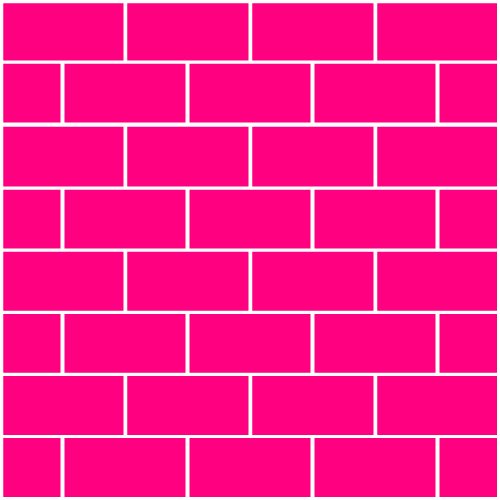
Traditional laying patterns and examples
With traditional laying patterns, you may be thinking uniform appearance with equally sized slabs. Well, you might be surprised to know random layouts are one of the most traditional choices when it comes to laying paving. Typically, these designs will combine multiple factors:
- At least three different-sized slabs
- No directional line layouts
- No repeating pattern
All these factors contribute to the “random” design. Here are some well-known examples of random layouts you can incorporate into your paving design.
Broken bond
When it comes to the broken bond layout, there’s no strict limit on the size of the slabs you can choose. However, it’s usually a good idea to go for at least three different slab sizes to create a random and visually appealing effect.
Also, keep in mind that the broken bond pattern is often arranged in a historic style, commonly referred to as the ‘transverse’ broken bond layout. This gives it a classic and timeless look.
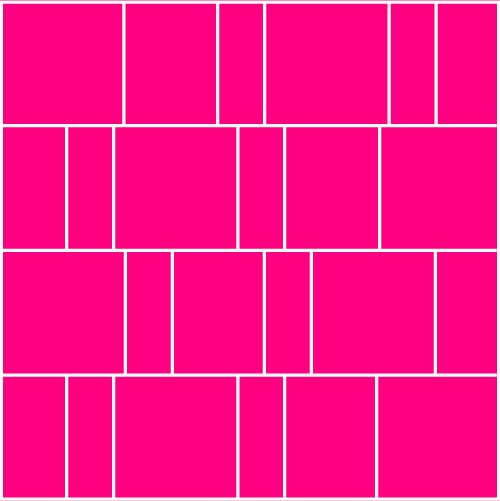
Tudor
The origin of the naming of this pattern is widely disputed. Regardless, it offers a trendy design that gives another random appearance. Unlike a broken bond, the Tudor pattern is designed with three slabs of completely differently shaped slabs.
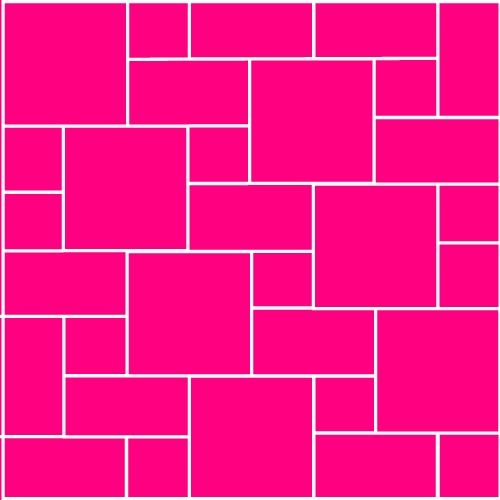
Multiple-gauged width
This design is similar to the stretcher bond pattern. It’s still random but also offers a slightly uniform appearance. Each slab will typically be of different lengths and widths; laid in rows or columns. The more different-sized slabs you use, the more random they can appear.
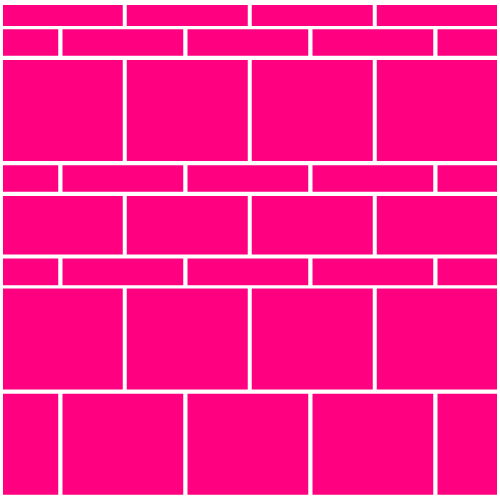
Bonus laying pattern and example
Another not-so-random pattern that can be used is the circular paving pattern. It’s exceptionally unique and able to grab attention.
How it works is you arrange the paving in a circular layout to create a focal point in the centre area of the patio. It’s a great style for natural stone paving slabs because you can typically find these shaped for a circular design.
Still not sure what style you want? Find out how to choose a paving pattern.
What can I do with paving edging?
A paving edge doesn’t only refer to the edge of a patio or similar flooring surface. There are plenty of paving edging ideas for flowerbeds or similar garden features.
| Paving edge idea | Features |
| Round top | •Simple style. •Natural-looking borders. |
| Scalloped | •Curved style. •Uniform lines. |
| Full rope | •Traditional style. •Suitable for stone patios and gravel. |
| Natural stone | •Sophisticated style. •Natural borders. |
| Stepping stones | •Practical style (can link areas together). •Suitable for grass, stones, or gravel. |
Are you laying your own paving? Find out how to in our guide to laying paving slabs. We also have small garden furniture ideas to help you learn what you could add to your new surface without compromising on style.














